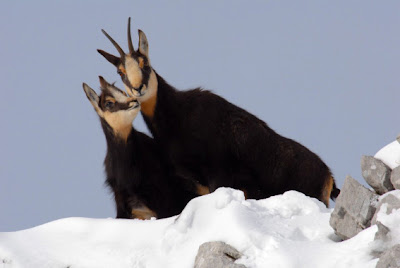The chamois,
(Rupicapra rupicapra), is a goat-antelope species native to mountains
in Europe, including the Carpathian Mountains of Romania, the European
Alps, the Tatra Mountains, the Balkans, parts of Turkey, and the
Caucasus. The chamois has also been introduced to the South Island of
New Zealand. Some subspecies of chamois are strictly protected in the EU
under the European Habitats Directive.
The English name is from the French chamois. This is derived from Latin camox, borrowed from Gaulish, itself perhaps a borrowing from Iberian or Aquitanian, akin to modern Basque ahuntz, "goat".
The usual pronunciation for the animal in British English is /ˈʃæmwɑː/, or in American English /ʃæmˈwɑː/, approximating the French pronunciation. However when referring to chamois leather, and in New Zealand often for the animal itself, it is /ˈʃæmi/, and sometimes spelt "shammy" or "chamy". The plural of "chamois" is spelled the same as the singular, and it may be pronounced with the final "s" sounded: /ˈʃæmwɑːz/, /ʃæmˈwɑːz/, /ˈʃæmiz/. However, as with many other quarry species, the plural for the animal is often pronounced the same as the singular.
The Dutch name for the chamois is gems, and the male is called a gemsbok. In Afrikaans, the name "gemsbok" came to refer to a species of Subsaharan antelope of the genus Oryx, and this meaning of "gemsbok" has been adopted into English.
The English name is from the French chamois. This is derived from Latin camox, borrowed from Gaulish, itself perhaps a borrowing from Iberian or Aquitanian, akin to modern Basque ahuntz, "goat".
The usual pronunciation for the animal in British English is /ˈʃæmwɑː/, or in American English /ʃæmˈwɑː/, approximating the French pronunciation. However when referring to chamois leather, and in New Zealand often for the animal itself, it is /ˈʃæmi/, and sometimes spelt "shammy" or "chamy". The plural of "chamois" is spelled the same as the singular, and it may be pronounced with the final "s" sounded: /ˈʃæmwɑːz/, /ʃæmˈwɑːz/, /ˈʃæmiz/. However, as with many other quarry species, the plural for the animal is often pronounced the same as the singular.
The Dutch name for the chamois is gems, and the male is called a gemsbok. In Afrikaans, the name "gemsbok" came to refer to a species of Subsaharan antelope of the genus Oryx, and this meaning of "gemsbok" has been adopted into English.





